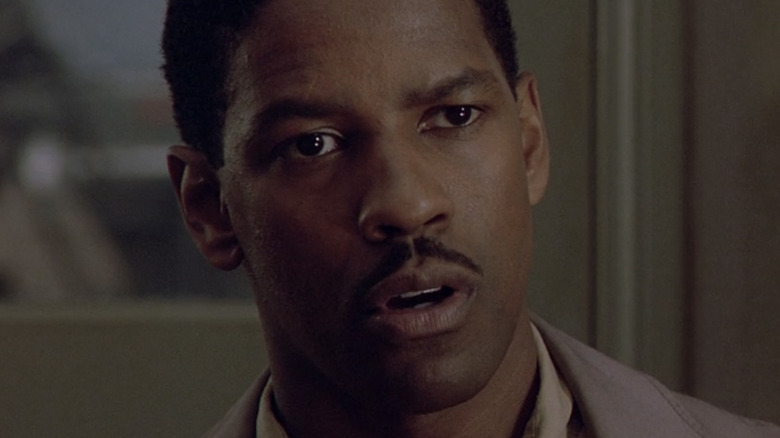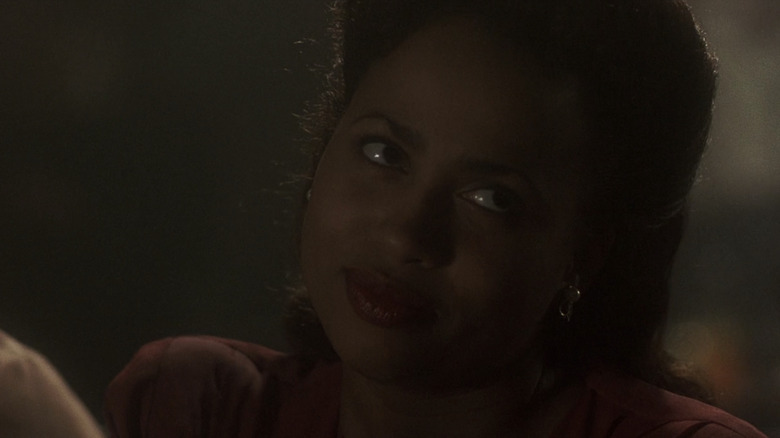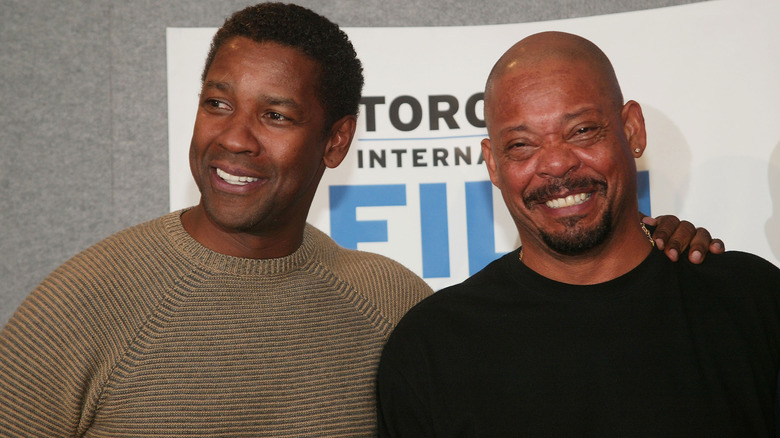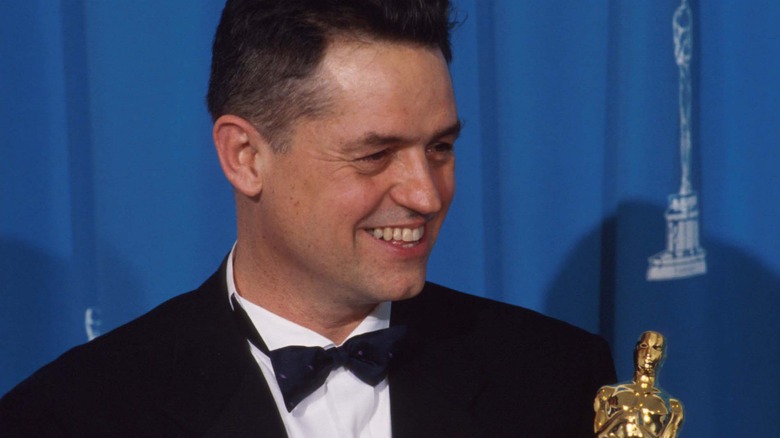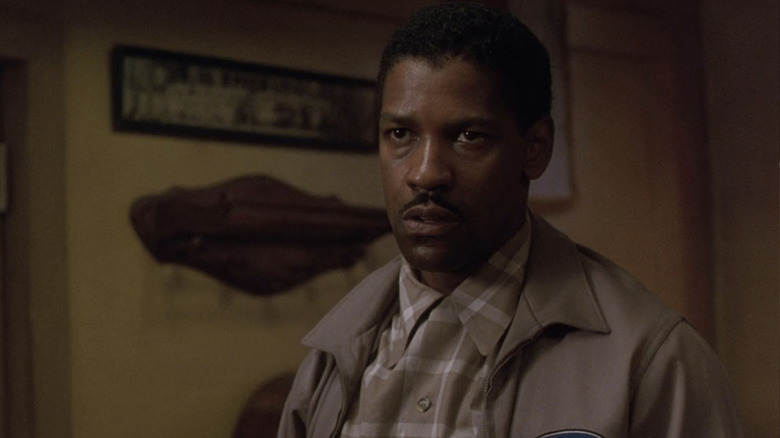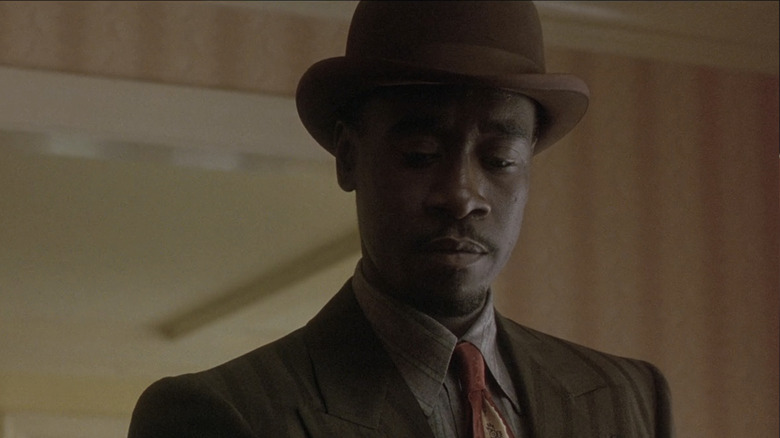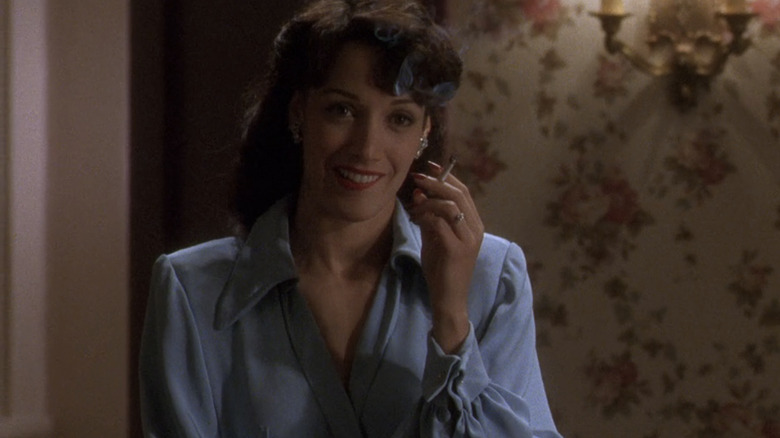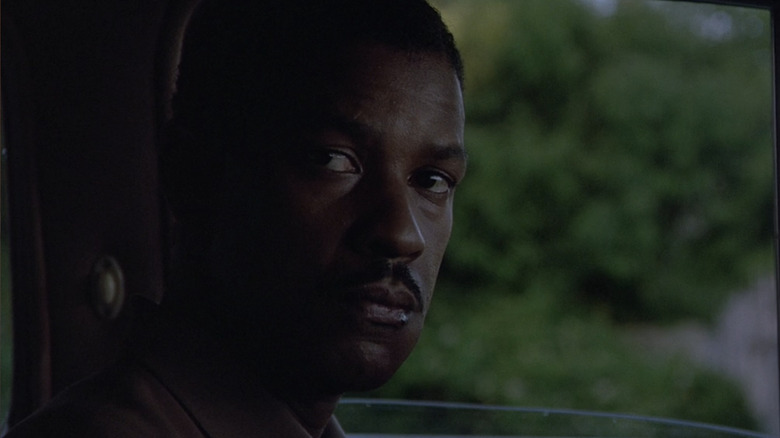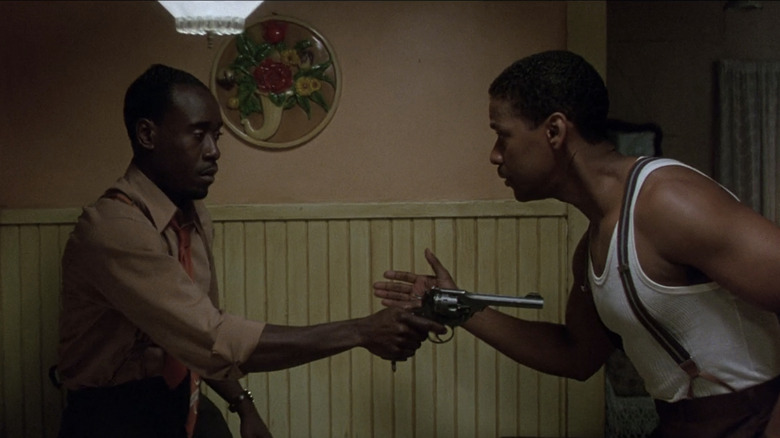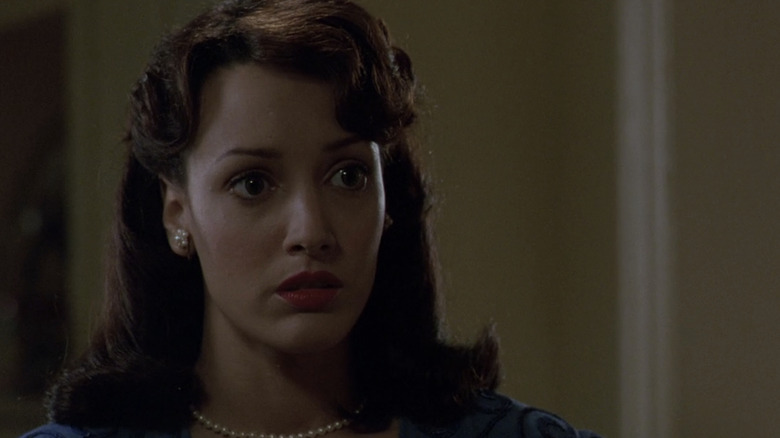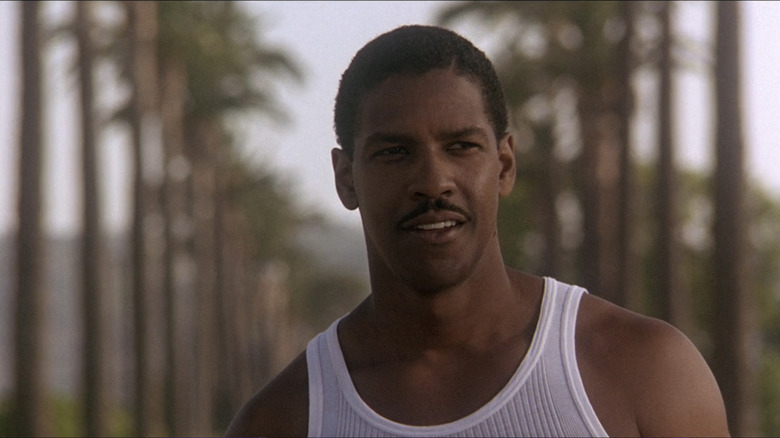The Untold Truth Of Devil In A Blue Dress
An ordinary man in over his head. A beautiful woman with secrets. Billows of cigarette smoke and bottles of whiskey. A murder that unravels a vast conspiracy.
These are the building blocks of hardboiled detective fiction and film noir, intertwined genres of literature and cinema that cast a cynical eye on the blinding positivity and upward mobility of post-World War II America. Carl Franklin's "Devil in a Blue Dress," based on the novel by Walter Mosley, is a film that hits all these beats and then some, but it is not cookie-cutter film noir. For one thing, it was released in 1995, decades after the heyday of the genre. More importantly, though, most of its characters are African American, and both the film and its source material are invested in telling the true history of Black life in Los Angeles in the decade before the Civil Rights Movement.
Starring Denzel Washington and Jennifer Beals, and featuring a ferocious breakthrough performance by Don Cheadle, the film earned solid reviews but did poorly at the box office, scuttling plans to adapt more of Mosley's novels featuring Black private eye Easy Rawlins. In the decades since its release, however, the film's reputation has improved, rightly earning a place among the best crime dramas of the 1990s — and in July 2022, it received a brand-new 4K restoration and Blu-Ray release from the Criterion Collection. Let's take a look at some of the things you might not know about "Devil in a Blue Dress."
Easy Rawlins, Private Eye
"Devil in a Blue Dress" was the debut novel for both the character of Easy Rawlins and his creator, author Walter Mosley. Easy (short for Ezekiel) is a veteran and recently laid-off factory worker living in 1948 Los Angeles. In need of money, he takes a job from a white man named Dewitt Albright, tracking down a white woman named Daphne Monet who frequents Black nightclubs. Before long, though, bodies start to pile up around Easy, and finding out where Daphne is becomes less important than who she is, and how she is connected to both the Black underworld and the mayor's office.
In an interview with author Attica Locke included on the film's Criterion release, Mosley said that the notion of a Black private eye intrigued him as someone who could be invisible on both sides of the color line: Black people wouldn't expect him to be a detective, while white people wouldn't expect him to be anything. A lifelong Angeleno, Mosley also wanted to write about the men and women of his parents' generation who came to California from the South for a better life, only to find the same old Jim Crow forces at work. Publisher Simon and Schuster purchased the novel with the expectation that he would write more Easy Rawlins mysteries. As of 2022, Mosley has published 15 books in the series, as well as dozens of other works of fiction, non-fiction, erotica, screenplays, and graphic novels.
Carl Franklin, Director
Carl Franklin had built up a solid resume of bit parts on television in the 1970s and 1980s before he pivoted from acting to directing, enrolling at the American Film Institute and directing his thesis short film "Punk," starring an unknown young actor named Don Cheadle, in 1986. Six years later, with a few Roger Corman cheapies under his belt, Franklin helmed the small-town crime thriller "One False Move," starring Bill Paxton and co-written by Billy Bob Thornton.
The film's distributor, IRS Media, primarily dealt in direct-to-video films, which is what "One False Move" originally was. But producer Jesse Beaton, whom Franklin would later marry, had the foresight to book the film in a few festivals, where it garnered strong reactions from the critics who saw it, particularly Roger Ebert. Beaton was able to convince IRS that a limited theatrical run in the cities where it had played the festival circuit — Seattle, Los Angeles, and Chicago — would bring in strong reviews that would look good on a VHS box. IRS agreed, and Ebert championed the film along with Gene Siskel on their nationally syndicated show, naming it one of the best films of 1992. "One False Move" would eventually play in over 50 markets in the United States, and its success gave Franklin the clout to pick his next project.
Jonathan Demme, Producer
Franklin made a number of new admirers with "One False Move," one of which was filmmaker Jonathan Demme. A fellow alum of the Roger Corman school of moviemaking, Demme was in the midst of an incredible run of hit films that included 1988's "Married to the Mob," the horror classic "The Silence of the Lambs," and the social drama "Philadelphia" starring Denzel Washington and Tom Hanks in an Oscar-winning performance. Demme had a development deal at Columbia/TriStar at the time and offered to executive produce Franklin's next film, whatever that might be. "Jonathan asked me what I wanted to do since he had a deal there," Franklin said told rogerebert.com in 2018, "and I said that I wanted to do 'Devil in a Blue Dress.'"
Luckily, so did everyone else. Both Demme and his "Philadelphia" star Washington had expressed interest in the novel, as had Wesley Snipes at a certain point. Universal Pictures had purchased the rights to Mosley's first three Easy Rawlins novels, "Devil in a Blue Dress," 1991's "A Red Death," and 1992's "White Butterfly" with the intent of developing them into a franchise. But with Demme, Washington, and now Franklin at TriStar, parent company Sony negotiated the transfer of rights for the three novels. "It all coalesced and all the forces came together to allow us to make the movie," Franklin said.
Denzel, the star
In Roger Ebert's review of the 1989 island cop drama "The Mighty Quinn," he hailed Denzel Washington's performance as "one of those roles that creates a movie star overnight." Scholars might argue whether it was "The Mighty Quinn" or Washington's Oscar-winning turn in the Civil War film "Glory" that same year that did the trick, but by the time cameras rolled on "Devil in a Blue Dress," no one could deny that Washington was a bona fide movie star by any reasonable metric. Like Demme, Washington was in the midst of arguably the most fruitful period of his career, from starring in Spike Lee's epic "Malcolm X" to Demme's "Philadelphia" to the John Grisham paranoid thriller "The Pelican Brief."
Even though he came onto set with one Oscar and three nominations under his belt, Washington threw himself into the spirit of Franklin's meticulously recreated set. "Denzel is a stickler for research," Franklin told Slate in 2022. He visited the Fifth Ward neighborhood in Houston, Texas, where Easy is from, to learn people's speech patterns and accents. He requested his wardrobe months in advance so that he could wear it in everyday life and get a feel for it, working on the character from the outside in. In an interview with Don Cheadle conducted for the Criterion Collection release, Franklin recalls how Washington found an old photo of two young boys amongst the props collected for the film and kept it in his jacket pocket during filming, feeling that the boys in the picture were Easy and his friend Mouse, home in Texas.
Introducing Don Cheadle
Washington was a natural fit for Easy Rawlins: Charming, intelligent, someone the audience can trust to guide them through what is often a dark and brutal film. But to play Easy's trigger-happy childhood friend Raymond "Mouse" Alexander, Franklin turned to an actor who was less of a known quantity: His "Punk" star Don Cheadle.
Cheadle had been kicking around Hollywood for nearly a decade at this point, and would have perhaps been most recognizable (if at all) from the short-lived "Golden Girls" spin-off "The Golden Palace." Mouse is a wildcard, well-dressed with a bowler hat cocked to the side and at least two pistols on him at all times. Cheadle and Mouse enter the film around the halfway point like a bolt of lightning, bringing a livewire energy and smiling menace to every scene, and for his efforts Cheadle was nominated for a Screen Actors Guild Award and won the Los Angeles Film Critics Association Award for Best Supporting Actor.
Amazingly, Mouse was almost not in the film at all. While "Devil" was in development at Universal, Mosley had written a draft of the screenplay himself, where he had combined the characters of Easy and Mouse in order to make Easy more of an active protagonist. Once the project was taken over by Sony, Franklin was allowed to adapt the film himself, discarding Mosley's draft and the changes he had made. Restoring Mouse to the narrative not only gave Cheadle the breakout role of his career, but also arguably the best line in the film, as Mouse justifies his killing of Easy's treacherous friend Joppy (the late Mel Winkler): "Easy, if you ain't want him killed, why'd you leave him with me?"
The Devil Herself
As casting for the film was underway, word on the street in Hollywood was that Franklin was seeking an unknown actress for the role of Daphne Monet, the titular devil in a blue dress whose love affair with wealthy mayoral candidate Todd Carter (Terry Kinney) sets the plot into motion. Jennifer Beals was no unknown, having starred in Adrian Lyne's stylish, influential "Flashdance" a decade earlier, but she was desperate for the part — and frustrated that her agents at the time couldn't get her an audition. Eventually, she took matters into her own hands.
"My agents were calling, no one could get me a reading," she told interviewer Bobbie Wygant in 1995, "and finally I just called [Franklin] myself and begged him."
Franklin was indeed uncertain about casting Beals in the role, but not because of her acting ability. "When she came in, she was clearly the best actress," he told critic Robert Daniels in a 2022 interview for The Playlist. Rather, his concern was that casting a biracial actress like Beals would spoil the film's biggest twist, that Daphne Monet is actually a mixed-race woman passing as white. The revelation changes our understanding of Daphne, from a femme fatale to a tragic heroine caught between her heart and the color line.
"Fortunately," Franklin said, "many people were either unaware of [Beals' racial background], or they simply went along with a mixed-race woman playing white."
Central Avenue
One of both Mosely and Franklin's aims with "Devil in a Blue Dress" was to use the detective genre as a frame for chronicling African American life in the post-war decade, in all of its joys and dangers. At the very start of the film, Franklin and his collaborators — cinematographer Tak Fujimoto and production designer Gary Frutkoff — show off their vibrant recreation of Central Avenue, which, like Beale Street in Memphis and Maxwell Street in Chicago, was the epicenter of Black culture in midcentury Los Angeles. Likewise, the clean, safe streets of Easy's Watts neighborhood stand in stark contrast with the media's depiction of the city in subsequent decades.
But despite the fact that Southern California was sold to African American migrants as a haven from the segregation and violence of the Jim Crow South, the lives of Black Angelenos were still heavily curtailed by racist policies, redlining, and police brutality. Easy knows this fact all too well, and the film captures his unease when out at night anywhere else but Central Avenue, at a time in American history when "sundown towns" were common from coast to coast. A tense scene at the Malibu pier at night, when Easy is confronted by a group of white men after sharing a few polite words with a white woman, is a vivid example of the dangers he faces, specifically as a Black man. His fellow literary shamus Philip Marlowe would never need to sneak into a whites-only hotel through the service entrance, as Easy does for his first meeting with Daphne.
Reception
The film was released on September 29, 1995 to mostly positive reviews. Roger Ebert, who championed "One False Move" so much that Franklin still tearfully credits his film career to the famed critic, was actually one of the film's few mild detractors, giving "Devil" three stars and writing, "I liked the period, tone, and look more than the story, which I never really cared much about."
The film arrived at the crossroads of two contemporary filmmaking trends: A boom in dramas geared toward African American audiences by directors like Spike Lee, John Singleton, Julie Dash, and the Hughes Brothers; and a mini-resurgence in films with a noir sensibility and aesthetic like John Dahl's "Red Rock West" and "The Last Seduction," the Coen brothers' "Miller's Crossing," and even Tim Burton's trenchcoat-and-fedora-clad "Batman" movies. Despite these twin movements, "Devil in a Blue Dress" did poorly at the box office, grossing just over $16 million in the United States and shutting down any plans for a sequel.
Over the years, Franklin has mused over the film's failure at the box office. When asked about it at the Music Box in 2018, he made the point that film noir as a genre has always been valued by critics and film buffs more so than general audiences. "'Chinatown,' as fantastic as that movie was ... was not a huge success financially at the time." In 2022, he also noted that the film was released on the eve of a verdict in the OJ Simpson murder case, when a movie about a Black man searching for a white woman in Los Angeles may not have been the most palatable for audiences.
Revitalization
Audiences may have stayed out of the theaters in 1995, but the film's positive critical reception has only grown over the decades. In 2021 The Ringer named it as one of the best of the unexpected crop of neo-noir films of the 1990s; the same year, critics David Fear and Bilge Ebiri put the film in the top 20 of Denzel Washington's film performances for Rolling Stone. When the Music Box Theater celebrated the 10th anniversary of its "Noir City Chicago" festival in 2018, Franklin was invited to speak at a special double-feature screening of "Devil in a Blue Dress" and "One False Move." The rest of the festival featured hits and hidden gems from the first generation of noir classics like "The Blue Dahlia" and "The Scarlet Hour." "Devil" is no longer just a neo-noir or a stylish copy of the real thing, but a classic of the genre in its own right.
In July 2022 the Criterion Collection released a 4K restoration of "Devil," complete with new interviews with Mosley, Franklin, and Cheadle, a vintage commentary track by Franklin from the film's first DVD release in 1998, and a new essay by critic Julian Kimble. "Franklin's film isn't just 'Chinatown' painted Black," he writes. "It's a taut story about Black people's ongoing struggles and a gem that shines on noir's possibilities with race front and center."
Devil in a...Bluer Dress?
"Devil in a Blue Dress" is a modern classic, a heady blend of genre thrills and social history, and just the tip of the iceberg since there are more than a dozen additional Easy Rawlins novels waiting to be put in front of the camera. So, where are the sequels?
Every few years since "Devil" came and went in theaters, there has been rumors of restarting the franchise on television — "rumblings," as Franklin has put it — but little more than that. In February 2021 it was announced that Steven Spielberg's Amblin Entertainment was developing a television series based on Mosley's novels, with "Stomp the Yard" director Sylvain White producing and directing the pilot episode. As of August 2022, however, no further news about this project has come out.
If Easy and Mouse are to return to the screen, whether the big or small one, what are the chances that Washington and Cheadle might reprise their roles? As Mosley has continued to write Easy Rawlins mysteries, he has allowed the characters to age through the decades; his latest novel, 2021's "Blood Grove," takes place in the late 1960s. Could Washington, pushing 70, still wear the fedora and undershirt of a 50-year-old Easy? Like a private eye on a stakeout, we'll just have to wait and see.
